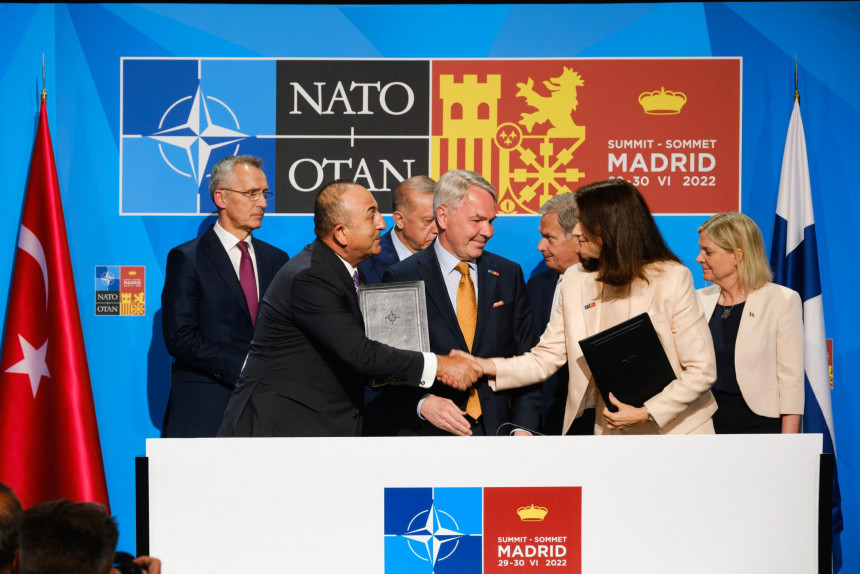If NATO enlargement is a problem for Russia, now is a particularly dangerous moment

NATO will deploy weaponry in Latvia. That is good. But those who know how to handle this weaponry will be sent out from their home countries to threatened regions only as soon as the hour of crisis arrives and the appropriate political decisions are taken. For example, to the Baltic States. It would be absurd if a Latvian had to stand in front of warehouses full of sophisticated armaments like a sheep in front of a new gate.
The most important developments concerning NATO's force build-up and the defense of the eastern flank against Russia were already outlined on the first day of the Madrid meeting. The big news is that Turkey has traded what was important to it - the unhindered fight against the Kurdish rebels and the lifting of restrictions on military procurement - for the green light for Sweden and Finland to join the NATO alliance. NATO leaders tell us that NATO is now an even stronger and even safer organization, and our ministers also tweet this as great news, but there is a catch. The accession procedure will not end today or tomorrow. It is true that the discussions on the accession of the two countries to the alliance have taken place almost at the speed of light. It was only in May that a formal application was submitted, and already in June the leaders of the Alliance gave their approval. But all the technical preparations and ratification by the parliaments of the 30 Member States are still to come. This could take a year or so. And it is this period before Finland and Sweden become full NATO members that will be the most dangerous for our region.
Response force x10
As military analyst and reserve captain Mārtiņš Vērdiņš points out: "If Russia wants to do something against NATO, it has to do it now." With the turbulence still around Kaliningrad, it is a very uncomfortable moment, which leads to the next question on the agenda - how NATO will protect us in this new situation of insecurity. A more detailed explanation by NATO's chief spokesman, Secretary General Jens Stoltenberg, was already given in the morning briefing on the first day of the Summit. Two key elements will strengthen NATO's deterrence and defense capabilities. Response forces will be significantly increased and military equipment will be deployed in defended areas. The Alliance already has a response force of 30,000 troops deployed in their home countries and, if necessary, they deploy to carry out the necessary military operations, following a unanimous decision by the Alliance. By next year, this force will be increased tenfold. So to 300,000. But, as before, they will be permanently stationed in their home countries, rotating from time to time for joint training exercises in specific protected areas. For example, the Baltic States. This is essentially what is already happening now, but will be intensified in the future.
Military equipment on the front
But what matters in warfare is not the number of boots on the ground, but what these units are equipped with. What armored vehicles and tanks, what planes and ships, what missile systems come with them. And that is the other important message: NATO will deploy military equipment in the countries that are under increased protection, which, because of the Russian threat, includes us. As Mārtiņš Vērdiņš admits, this is indeed a major step forward, because military logistics, especially in times of war, is a huge challenge. All the quantities of equipment and personnel need to be lifted, stacked on planes, ships and wagons. In addition, the width of the rails still varies from country to country. A real nightmare. However, even if a bunch of warehouses for war materiel are built in Latvia as quickly as possible, the question remains: who will be allowed to operate and use the materiel? Of course, whoever owns it and whoever is trained to use it. But it would not be acceptable that, when the hour of crisis arrives, reinforcements or even a political decision are still on the way, but the Latvians on the ground cannot do anything more serious because they do not know how to operate the goodies they have stacked in their warehouses. It is also far from easy for the Ukrainians to learn how to use the materiel sent by the West, because the systems are extremely complex and there is no time to learn. They have to fight right now.
Who will train the Latvians?
Neatkarīgā has already reported that the air defense system - a battery of NASAMS surface-to-air missiles owned by Spain - has been sent to the Lielvārde base. The Spaniards brought it and the Spaniards are servicing it. No Latvian training is planned, except in cooperation with our fire correctors. So there is a superb weapon available that only the visiting soldiers know how to operate. Of course, in the current circumstances, the number of guest soldiers on NATO's eastern flank must be increased. We currently have around 1,700 troops from 10 allied countries rotating with us - the Latvian Battle Group of the NATO enhanced presence. This needs to be increased to the level of a brigade capable of operating semi-autonomously - with at least 4,000 troops and an appropriate amount of heavy military equipment. As for the Latvians' ability to work with these sophisticated weapons systems, the question is the same old one: where to get the soldiers to be trained. Unlike our neighbors, Latvia's defense policy makers still stick to the principle of absolute voluntarism in recruiting troops, and the introduction of compulsory military service is not on the table in the context of the NATO meeting taking place these days either.
